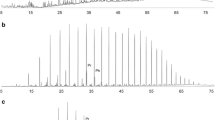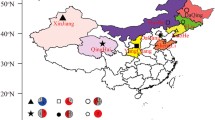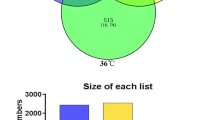Abstract
Microbial diversity within formation water and oil from two compartments in Bokor oil reservoir from a Malaysian petroleum oil field was examined. A total of 1,056 16S rRNA gene clones were screened from each location by amplified ribosomal DNA restriction analysis. All samples were dominated by clones affiliated with Marinobacter, some novel Deferribacteraceae genera and various clones allied to the Methanococci. In addition, either Marinobacterium- or Pseudomonas-like operational taxonomic units were detected from either compartment. A systematic comparison with the existing pertinent studies was undertaken by analysing the microbial amplicons detected and the PCR primers used. The analyses demonstrated that bacterial communities were site specific, while Archaea co-occurred more frequently. Amplicons related to Marinobacter, Marinobacterium and Pseudomonas were detected in a number of the studies examined, suggesting they may be ubiquitous members in oil reservoirs. Further analysis of primers used in those studies suggested that most primer pairs had fairly broad but low matches across the bacterial and archaeal domains, while a minority had selective matches to certain taxa or low matches to all the microbial taxa tested. Thus, it indicated that primers may play an important role in determining which taxa would be detected.

Similar content being viewed by others
References
Allen EE, Banfield JF (2005) Community genomics in microbial ecology and evolution. Nat Rev Microbiol 3:489–498
Antunes A et al (2007) Marinobacter salsuginis sp. nov., isolated from the brine-seawater interface of the Shaban Deep, Red Sea. Int J Syst Evol Microbiol 57:1035–1040
Bastin ES (1926) The problem of the natural reduction of sulphates. AAPG Bull 10:1270–1299
Bonch-Osmolovskaya EA et al (2003) Radioisotopic, culture-based, and oligonucleotide microchip analyses of thermophilic microbial communities in a continental high-temperature petroleum reservoir. Appl Environ Microbiol 69:6143–6151
Chouari R, Paslier DL, Daegelen P, Ginestet P, Weissenbach J, Sghir A (2005) Novel predominant archaeal and bacterial groups revealed by molecular analysis of an anaerobic sludge digester. Environ Microbiol 7:1104–1115
Colwell RK (1997) EstimateS: statistical estimation of species richness and shared species from samples. Version 8.0.0. User’s Guide and application published at: http://purl.oclc.org/estimates
Dahle H, Garshol F, Madsen M, Birkeland N-K (2008) Microbial community structure analysis of produced water from a high-temperature North Sea oil-field. Antonie van Leeuwenhoek 93:37–49
DeLong EF (1992) Archaea in coastal marine environments. Proc Natl Acad Sci USA 89:5685–5689
DeLong EF (2004) Microbial population genomics and ecology: the road ahead. Environ Microbiol 6:875–878
Edgar R (2004) MUSCLE: multiple sequence alignment with high accuracy and high throughput. Nucleic Acids Res 32:1792–1797
Felsenstein J (2005) PHYLIP (Phylogeny Inference Package) Version 3.6. Distributed by the author. Department of Genome Sciences, University of Washington, Seattle, p 5
Fuhrman JA, Davis AA (1997) Widespread Archaea and novel Bacteria from the deep sea as shown by 16S rRNA gene sequences. Mar Ecol Prog Ser 150:275–285
Gonzalez JM, Mayer F, Moran MA, Hodson RE, Whitman WB (1997) Microbulbifer hydrolyticus gen. nov., sp. nov., and Marinobacterium georgiense gen. nov., sp. nov., two marine bacteria from a lignin-rich pulp mill waste enrichment community. Int J Syst Bacteriol 47:369–376
Grabowski A, Nercessian O, Fayolle F, Blanchet D, Jeanthon C (2005) Microbial diversity in production waters of a low-temperature biodegraded oil reservoir. FEMS Microbiol Ecol 54:427–443
Hall C, Tharakan P, Hallock J, Cleveland C, Jefferson M (2003) Hydrocarbons and the evolution of human culture. Nature 426:318–322
Head IM, Jones DM, Larter SR (2003) Biological activity in the deep subsurface and the origin of heavy oil. Nature 426:344–352
Head IM, Jones DM, Roling WFM (2006) Marine microorganisms make a meal of oil. Nat Rev Microbiol 4:173–182
Ibrahim Z (2004) Simulation analysis of microbial well treament of Bokor field, Malaysia. In: SPE Asia Pacific oil and gas conference and exhibition. Paper number SPE 88453, Perth, Australia
Iino T, Nakagawa T, Mori K, Harayama S, Suzuki K-I (2008) Calditerrivibrio nitroreducens gen. nov., sp. nov., a thermophilic, nitrate-reducing bacterium isolated from a terrestrial hot spring in Japan. Int J Syst Evol Microbiol 58:1675–1679
Karim MGA, Salim MAH (2001) Microbial enhanced oil recovery (MEOR) technology in Bokor field, Sarawak. In: SPE Asia Pacific improved oil recovery conference. Paper number SPE 72125
Lake LW (1989) Enhanced oil recovery. Prentice Hall, Englewood Cliffs
Li D, Hendry P (2008) Microbial diversity in petroleum reservoirs. Microbiol Aust 29:25–27
Li H, Yang SZ, Mu BZ, Rong ZF, Zhang J (2006) Molecular analysis of the bacterial community in a continental high-temperature and water-flooded petroleum reservoir. FEMS Microbiol Lett 257:92–98
Li H, Yang SZ, Mu BZ (2007a) Phylogenetic diversity of the archaeal community in a continental high-temperature, water-flooded petroleum reservoir. Curr Microbiol 55:382–388
Li H, Yang SZ, Mu BZ, Rong ZF, Zhang J (2007b) Molecular phylogenetic diversity of the microbial community associated with a high-temperature petroleum reservoir at an offshore oilfield. FEMS Microbiol Ecol 60:74–84
Ludwig W et al (2004) ARB: a software environment for sequence data. Nucleic Acids Res 32:1363–1371
Magot M, Ollivier B, Patel BKC (2000) Microbiology of petroleum reservoirs. Antonie van Leeuwenhoek 77:103–116
Midgley DJ et al (2010) Characterisation of a microbial community associated with a deep, coal seam methane reservoir in the Gippsland Basin, Australia. Int J Coal Geol 82:232–239
Nemati M, Jenneman GE, Voordouw G (2001) Impact of nitrate-mediated microbial control of souring in oil reservoirs on the extent of corrosion. Biotechnol Progress 17:852–859
Oliveira VMD, Sette LD, Simioni KCM, Santos Neto EVD (2008) Bacterial diversity characterization in petroleum samples from Brazilian reservoirs. Braz J Microbiol 39:445–452
Orphan VJ, Taylor LT, Hafenbradl D, Delong EF (2000) Culture-dependent and culture-independent characterization of microbial assemblages associated with high-temperature petroleum reservoirs. Appl Environ Microbiol 66:700–711
Palleroni NJ (2005) Genus I. Pseudomonas In: Brenner NRK DJ, T. Staley J, Garrity GM (ed) Bergey’s manual of systematic bacteriology, 2nd edn. Springer, East Lansing, pp 323–379
Pham VD et al (2009) Characterizing microbial diversity in production water from an Alaskan mesothermic petroleum reservoir with two independent molecular methods. Environ Microbiol 11:176–187
R Development Core Team (2010) R: a language and environment for statistical computing. R Foundation for Statistical Computing, Vienna, Austria. ISBN 3-900051-07-0. http://www.R-project.org
Raes J, Bork P (2008) Molecular eco-systems biology: towards an understanding of community function. Nat Rev Microbiol 6:693–699
Reardon CL et al (2004) Composition and diversity of microbial communities recovered from surrogate minerals incubated in an acidic uranium-contaminated aquifer. Appl Environ Microbiol 70:6037–6046
Schloss PD, Handelsman J (2005) Introducing DOTUR, a computer program for defining operational taxonomic units and estimating species richness. Appl Environ Microbiol 71:1501–1506
Sette L, Simioni K, Vasconcellos S, Dussan L, Neto E, Oliveira V (2007) Analysis of the composition of bacterial communities in oil reservoirs from a southern offshore Brazilian basin. Antonie van Leeuwenhoek 91:253–266
She Y et al (2008) Analysis on the microbial diversity of qinghai high salt content oil reservoirs. In: 2nd International conference on bioinformatics and biomedical engineering, ICBBE 2008, pp 780–783
Sorensen KB, Canfield DE, Teske AP, Oren A (2005) Community composition of a hypersaline endoevaporitic microbial mat. Appl Environ Microbiol 71:7352–7365
Takai K et al (2005) Marinobacter alkaliphilus sp. nov., a novel alkaliphilic bacterium isolated from subseafloor alkaline serpentine mud from Ocean Drilling Program Site 1200 at South Chamorro Seamount, Mariana Forearc. Extremophiles 9:17–27
Van Der Kraan GM, Bruining J, Lomans BP, Van Loosdrecht MCM, Muyzer G (2009) Microbial diversity of an oil–water processing site and its associated oil field: the possible role of microorganisms as information carriers from oil-associated environments. FEMS Microbiol Ecol 71:428–443
van Elsas JD, Mäntynen V, Wolters AC (1997) Soil DNA extraction and assessment of the fate of Mycobacterium chlorophenolicum strain PCP-1 in different soils by 16S ribosomal RNA gene sequence based most-probable-number PCR and immunofluorescence. Biol Fertil Soils 24:188–195
Voordouw G et al (1996) Characterization of 16S rRNA genes from oil field microbial communities indicates the presence of a variety of sulfate-reducing, fermentative, and sulfide-oxidizing bacteria. Appl Environ Microbiol 62:1623–1629
Wang Q, Garrity GM, Tiedje JM, Cole JR (2007) Naive Bayesian classifier for rapid assignment of rRNA sequences into the new bacterial taxonomy. Appl Environ Microbiol 73:5261–5267
Yamane K et al (2008) Diversity and similarity of microbial communities in petroleum crude oils produced in Asia. Biosci Biotechnol Biochem 72:2831–2839
Acknowledgments
We would like to thank CSIRO MEOR team for their helpful discussion, Dr. Keyu Liu for information on the chemical composition of the formation waters and Dr Nai Tran-Dinh for internal review of the manuscript. Our special thanks also go to the two anonymous reviewers, editor, Jörg Overmann, and the chief editor, Erko Stackebrandt, for their comments and suggestions.
Author information
Authors and Affiliations
Corresponding author
Additional information
Communicated by Joerg Overmann.
Electronic supplementary material
Below is the link to the electronic supplementary material.
Rights and permissions
About this article
Cite this article
Li, D., Midgley, D.J., Ross, J.P. et al. Microbial biodiversity in a Malaysian oil field and a systematic comparison with oil reservoirs worldwide. Arch Microbiol 194, 513–523 (2012). https://doi.org/10.1007/s00203-012-0788-z
Received:
Revised:
Accepted:
Published:
Issue Date:
DOI: https://doi.org/10.1007/s00203-012-0788-z




